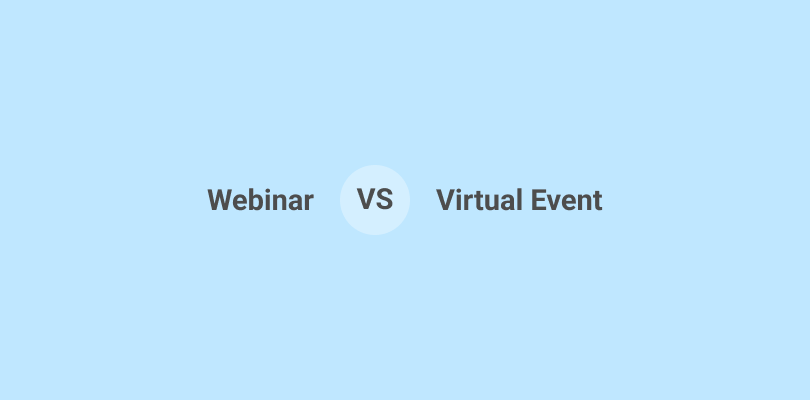Expand markets, boost profits, engage employees, optimize resources, and innovate – that’s business goals.
Sounds interesting? How do you define webinar goals?
Well, having been in the webinar industry for nearly a decade, I can summarize it as audience engagement, lead generation, community building, education, and feedback collection.
But as easy as it sounds, there’s a bigger picture to this.
Let’s uncover everything about webinar goals and objectives and how they help shape your webinar strategy for better engagement.
But before that, here’s a quick video from a webinar expert to help you learn some crucial things before you even set your goals:
What is Webinar Goal Setting?
Webinar goal setting involves deciding what you want to achieve through your webinar. This could be anything from generating leads, educating your audience, or promoting a product. A clear, smart webinar goal will help you design content and strategy to meet your objective
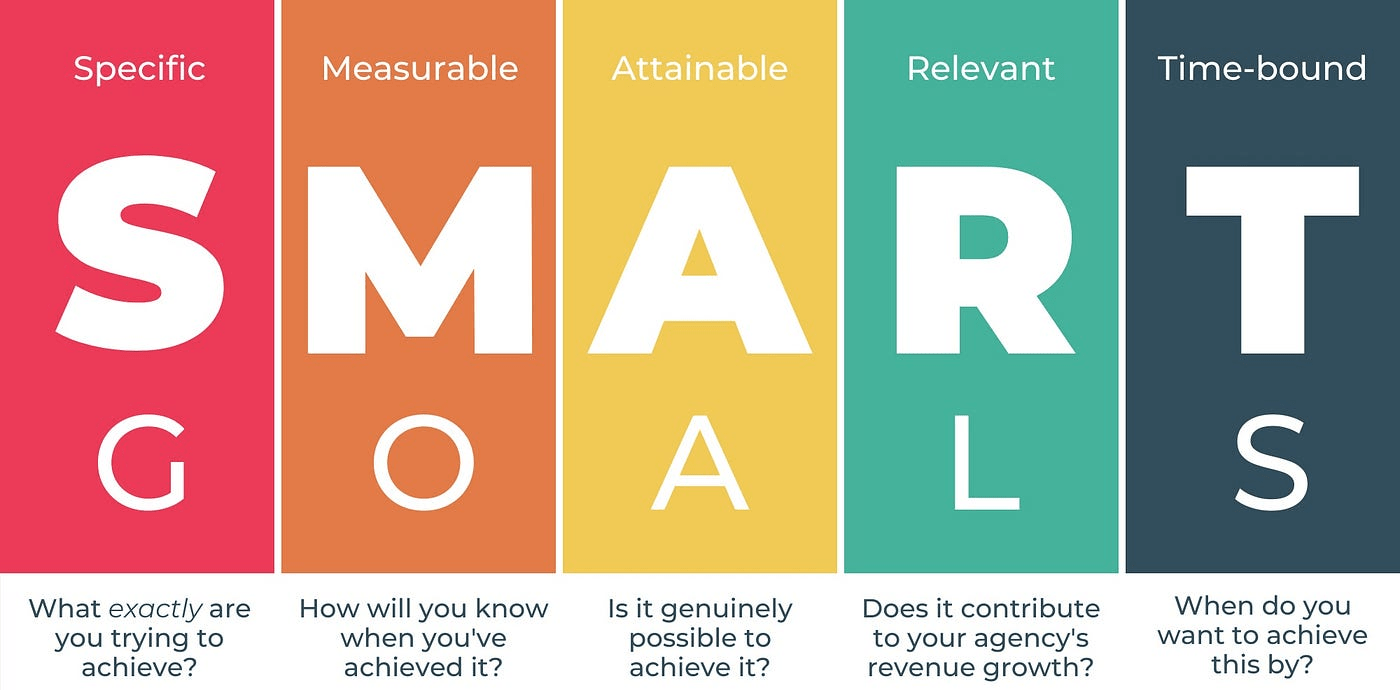
For example, if your goal is to sell a new product, your webinar could include demos, customer testimonials, and a Q&A session to address concerns. This helps you focus on what’s essential, ensuring the content and format align with achieving your primary outcome.
Why Are Webinar Goals Important
Webinar goals are important because they give direction and purpose to your event. This is especially true if you’re running a goal-setting webinar where participants expect to learn how to define their own objectives. Clear goals help measure success, whether driving leads, educating an audience, or building brand awareness.
They also guide content creation, promotion strategies, and engagement tactics, making the webinar more focused and relevant to attendees.
Without goals, you risk wasting time, effort, and resources on a webinar that doesn’t deliver tangible results or resonate with your audience.
How to Set Webinar Goals: A Step-by-Step Approach
Here’s a step-by-step guide to help you set webinar goals:
1. Identify Your Target Audience
Start by understanding who you are trying to reach. Narrow down your audience based on demographics, industry, or pain points. This clarity will guide every webinar aspect, ensuring your content resonates with the right people.
2. Define Your Core Message
Pinpoint the key takeaway you want your audience to learn. Craft this core message in a way that is both actionable and relevant. It should reflect your webinar’s value, whether it’s solving a problem or providing new insights.
3. Establish Measurable Success Metrics
Set clear and specific metrics to evaluate the effectiveness of your webinar. Whether it’s the number of sign-ups, attendee engagement, or post-webinar conversions, ensure these metrics are tied to your overarching goals.
4. Align Your Goals With Business Objectives
Ensure your webinar goals support your larger business strategy. This could include generating leads, building brand awareness, or nurturing existing relationships. When your goals align, your efforts will drive meaningful results.
5. Create a Timeline for Goal Achievement
Develop a timeline to reach your goals, including milestones along the way. This could range from pre-webinar promotions to post-event follow-ups. A detailed timeline ensures that your webinar stays on track and your goals are met within a reasonable period.
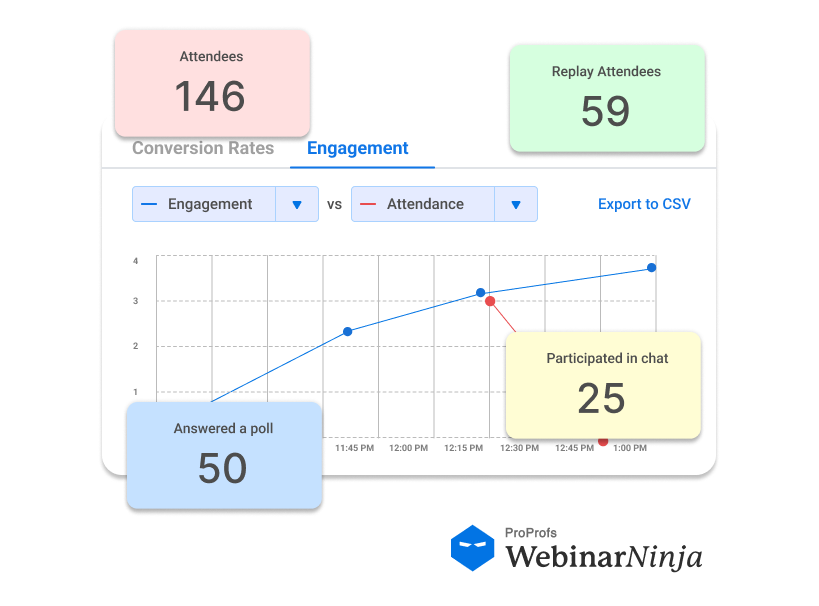
What Are the Types of Webinar Goals?
Webinar goals can vary depending on the purpose of the webinar, but here are a few key categories of webinar goals and objectives with examples:
1. Lead Generation
Goal: Attract potential customers or clients by offering valuable, relevant content in exchange for their contact information. The goal is to build a pool of qualified leads who are interested in your products or services. It’s a key step in nurturing relationships that could later turn into sales.
Example: A marketing firm hosts a webinar titled “SEO Strategies for 2024.” Attendees provide their emails upon registration, allowing the firm to follow up with personalized offers, case studies, and product demonstrations to nurture these leads into customers.
Here’s an interesting case study for you:
2. Customer Education
Goal: Provide existing customers with in-depth knowledge, training, or tips on how to maximize the use of your products or services. The focus is to increase customer satisfaction, reduce churn, and foster loyalty by ensuring customers get the most value from their purchases.
Example: An e-commerce platform hosts a webinar on “Leveraging Advanced Features for Better Sales Management.” The webinar walks users through complex features, helping them make better use of the platform, thus reducing support queries and enhancing long-term customer loyalty.
3. Brand Awareness
Goal: Increase your brand’s visibility by positioning your business as a leader in the industry. This type of webinar builds trust and recognition by sharing expertise, market trends, or insights, allowing your brand to stay top-of-mind when potential customers are ready to purchase.
Example: A healthcare startup organizes a webinar titled “The Future of Telemedicine: What You Need to Know.” The startup builds credibility and awareness by showcasing thought leadership and industry trends, making it a trusted name in the telemedicine space.
4. Product Launch or Demonstration
Goal: Showcase new or updated products/services by highlighting key features and benefits to spark excitement, early adoption, and immediate interest. These webinars are designed to provide attendees with a hands-on experience, demonstrate the product’s value, and encourage them to act, like signing up or purchasing.
Example: A SaaS company releases a new CRM tool and hosts a live demo webinar titled “Introducing [Product Name]: Simplify Your Sales Process.” The session walks potential customers through the product’s capabilities and encourages them to sign up for a trial immediately after the demo.
5. Thought Leadership
Goal: Establish your brand or company as an authority in your industry by sharing deep insights, research findings, or expert knowledge. The aim is to build trust with your audience and make them view you as a reliable source for industry trends and strategies.
Example: A tech consultancy hosts a webinar titled “Artificial Intelligence in Business: What the Future Holds.” By sharing expert opinions and data-backed trends, the firm builds its reputation as a thought leader, attracting potential clients interested in cutting-edge solutions.
6. Employee Training
Goal: Offer your employees access to training that enhances their skills, keeps them informed on company policies, or introduces them to new tools and processes. These webinars are intended to improve internal knowledge, productivity, and employee satisfaction while ensuring everyone is aligned with business goals.
Example: A multinational company hosts a webinar, “Effective Use of Collaboration Tools for Remote Teams.” The training session helps employees learn best practices for using tools like Slack and Zoom, ensuring seamless collaboration across teams working from different locations.
7. Internal Communication
Goal: Facilitate organizational communication by sharing updates, aligning team goals, or briefing teams on significant changes, strategies, or announcements. These webinars keep employees informed, engaged, and motivated to contribute toward common business objectives.
Example: A company rolls out a new product strategy and organizes an internal webinar titled “Our Roadmap for 2024: What You Need to Know.” The session keeps all departments updated on the strategic direction and goals, fostering a unified approach across the organization.
8. Customer Retention
Goal: Retain existing customers by offering webinars that provide added value, new ways to use your product, or advanced tips to improve their experience. Keeping customers engaged through educational content can increase loyalty and reduce the likelihood of churn.
Example: A fitness app hosts a webinar titled “Advanced Tips for Maximizing Your Workout Plans.” By continuously offering value, the app retains users, keeping them loyal and engaged over the long term.
9. Sales Enablement
Goal: Support the sales team by providing potential customers with in-depth knowledge of your products/services and answering common sales objections. This type of webinar helps sales teams close deals faster by giving prospects all the information they need to make a confident purchase decision.

Example: A B2B software company hosts a webinar called “How [Product Name] Solves Your Team’s Collaboration Problems.” The sales team uses this content to engage leads, address common concerns, and drive prospects to purchase.
10. Nonprofit Outreach or Advocacy
Goal: Raise awareness or advocate for a cause by educating your audience on specific social, environmental, or humanitarian issues. These webinars aim to engage the community, promote actions, or encourage donations while building a support network for the cause.
Example: A nonprofit organization hosts a webinar titled “The Impact of Climate Change: What Can We Do Now?” The webinar encourages viewers to donate, get involved in campaigns, and spread the message, helping the nonprofit amplify its reach and achieve its advocacy goals.
How to Track and Measure Webinar Goals
Tracking and measuring webinar goals is crucial for understanding the success of your event and optimizing future webinars. Here’s a step-by-step guide on how to track and measure these goals effectively:
1. Define Clear Webinar Goals
Before you can track or measure anything, you need to identify what success looks like. Common goals include:
- Lead generation: Increase in new leads or qualified leads.
- Brand awareness: The reach or attendance metrics.
- Customer education: Engagement or understanding of product/service.
- Sales conversions: Number of new or repeat sales generated.
- Community building: Retention or satisfaction of existing customers.
2. Choose Relevant Metrics
Based on your goals, identify which metrics best reflect progress. For example:
- Registration metrics:
- Number of registrations vs. attendees (attendance rate).
- Source of registration (e.g., organic, paid, referral).
- Engagement metrics:
- Average duration attendees stay (drop-off rate).
- Poll participation, Q&A activity, chat involvement.
- Downloading resources or clicking through to links.
- Post-webinar metrics:
- Survey responses (Net Promoter Score, satisfaction ratings).
- Follow-up engagement (e.g., email click-throughs or sales inquiries).
- Conversions (e.g., direct sales, subscriptions).
- Return on Investment (ROI):
- Cost per lead or cost per acquisition.
- Revenue generated from the webinar.
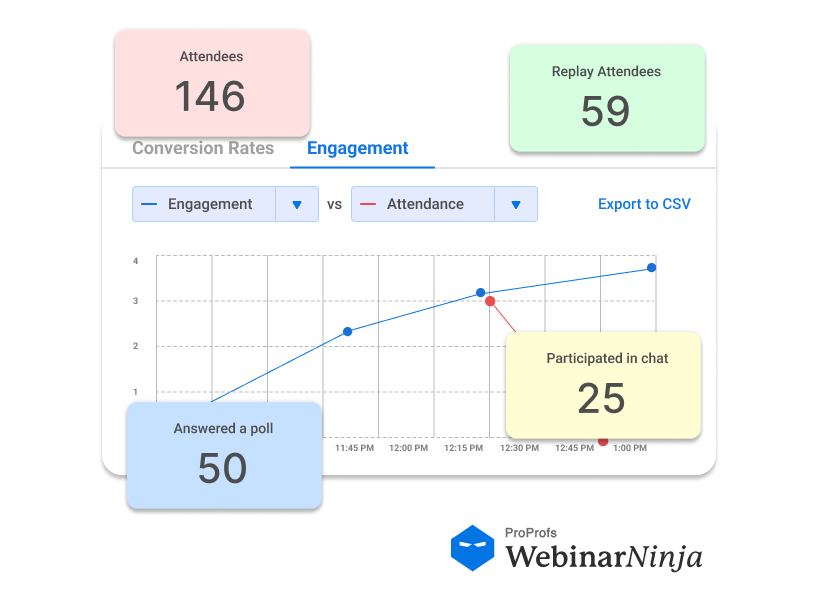
3. Use Tracking Tools
Utilize different tools to monitor key metrics:
- Built-In Webinar Analytics: Some good webinar platforms, such as WebinarNinja, provide built-in analytics (attendance, engagement). You can make use of these reports and analytics to track your goals.
- Marketing automation platforms: Tools like HubSpot, Marketo, or Mailchimp track lead generation, nurture campaigns, and post-webinar follow-ups.
- CRM systems: Track leads and sales progress, from initial interest to final conversions.
- Google Analytics: Use UTM codes and track traffic, conversions, and referral sources from your webinar promotions.
4. Set Benchmarks
Establishing benchmarks helps compare current performance with industry standards or your past webinars. This could include:
- Average attendance rate (typically between 35-50% of registrants).
- Average webinar length engagement.
- Conversion rates (e.g., percentage of attendees who become leads or customers).
5. Evaluate Audience Engagement
Engagement is a strong indicator of a webinar’s effectiveness:
- Measure interactivity (e.g., number of questions asked, polls answered).
- Use post-webinar surveys to gauge understanding, interest, and intent.
- Assess social media chatter or other discussions resulting from the webinar.
6. Monitor Post-Webinar Behavior
Tracking registrants and attendees after the webinar can provide insights into how well the content resonated:
- Follow up with emails or additional content and monitor open rates, click-through rates, and any direct inquiries.
- Track website visits or product page views after the event.
- See if attendees engage with additional resources, like case studies, eBooks, or product trials.
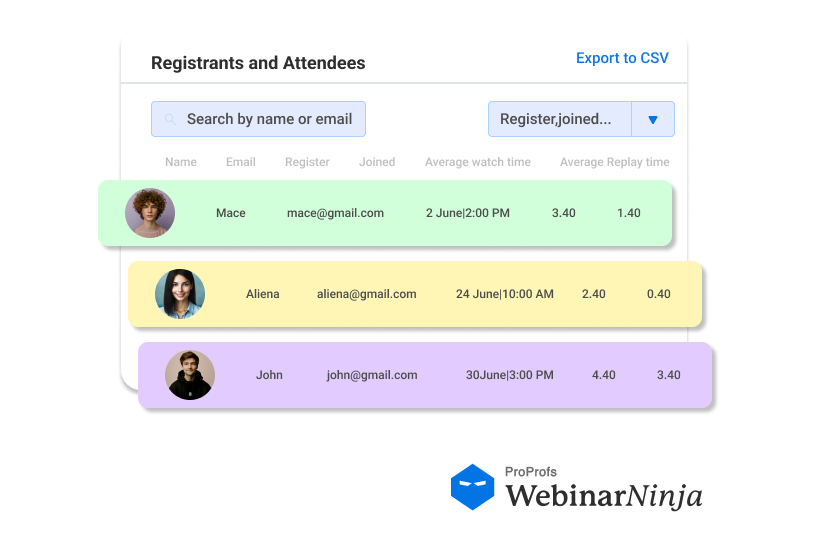
7. Analyze Conversion Data
- Lead quality: Did the webinar generate high-quality leads?
- Sales funnel: How many leads progressed through the funnel after the webinar?
- Revenue: How much revenue can be attributed to attendees over a certain period?
8. Reporting and Continuous Improvement
- Create detailed reports to analyze what worked and what didn’t.
- To find improvements, use A/B testing in future webinars (e.g., varying registration forms, email sequences, or webinar content).
- Set new, data-informed goals for future webinars based on the results.
| Pro Tip: Always keep an eye on your follow-up strategy! The true impact of your webinar often unfolds in the weeks that follow. Nurture your leads with personalized content and timely follow-ups to maximize engagement and conversion opportunities. |
How to Adapt Your Webinar Strategy According to Goals
Adapting your webinar strategy to align with specific goals is crucial to maximize its impact. Depending on your objectives – the format, content, and promotion of the webinar can vary significantly.
Here’s a guide on how to adapt your webinar strategy based on different goals:
1. Goal: Lead Generation
Focus: Attracting new potential customers and capturing their contact information.
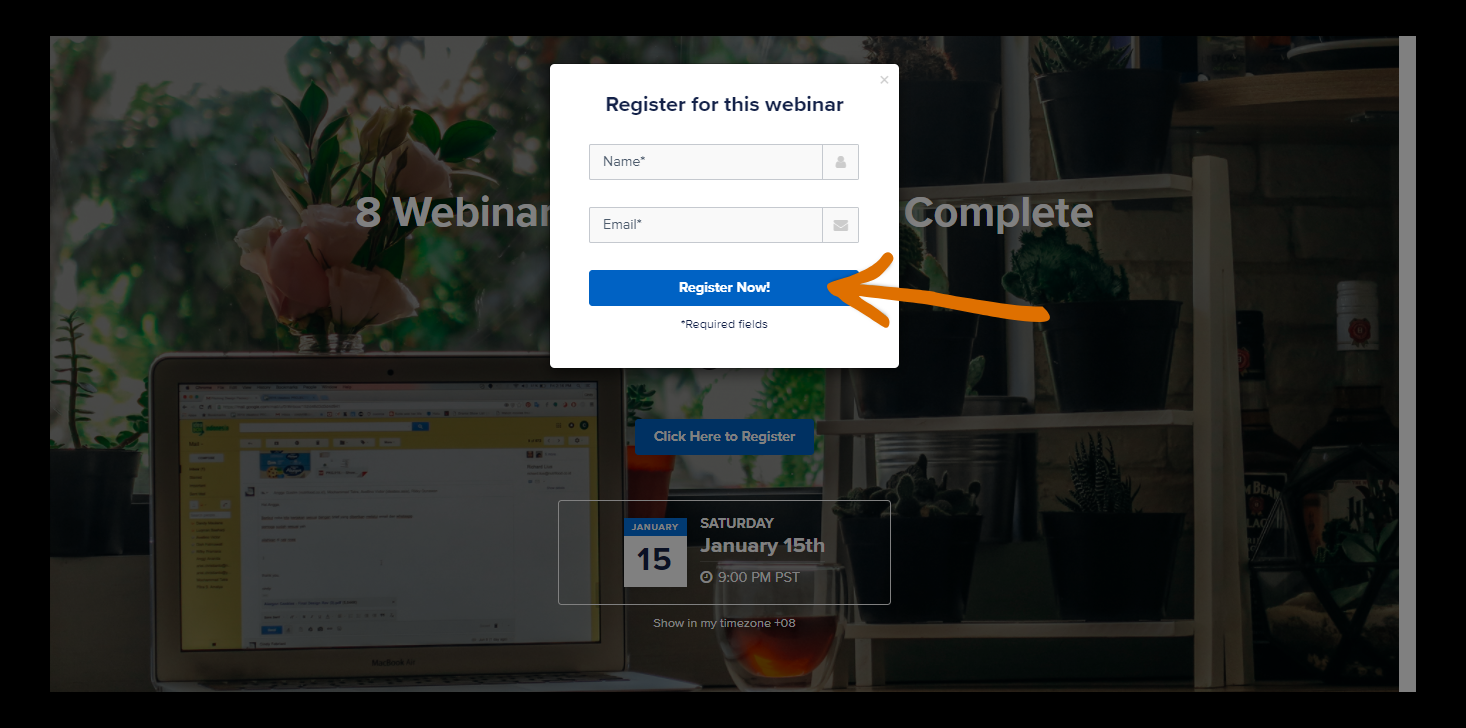
Strategy:
- Target Audience: Focus on prospects who are in the awareness or consideration stage of the buyer’s journey.
- Content: Provide value-driven content, such as industry insights, problem-solving techniques, or product overviews. Avoid too much sales talk.
- Promotion: Invest in paid advertising (Google, LinkedIn) to drive registrations. Use email campaigns targeting leads and industry-specific influencers.
- Call-to-Action: At the end, offer a resource, such as an eBook or whitepaper, that encourages attendees to share their contact details.
- Follow-up: Nurture leads with personalized emails or follow-up content based on the webinar’s topic.
2. Goal: Customer Education & Retention
Focus: Educating existing customers about product features, updates, or industry trends.
Strategy:
- Target Audience: Your current customer base.
- Content: Provide training, tutorials, or case studies on how to use your product effectively. Demonstrate advanced features and solutions to common pain points.
- Promotion: Send invitations to existing customers through email or in-app notifications. Highlight the benefits of attending, like learning advanced features or exclusive content.
- Call-to-Action: Encourage attendees to explore new features, upgrade their plans, or reach out to your support team for further assistance.
- Follow-up: Offer a webinar recording for future reference and follow up with personalized training resources.
3. Goal: Brand Awareness
Focus: Establishing your business as a thought leader in your industry.
Strategy:
- Target Audience: Industry professionals, influencers, and potential customers unfamiliar with your brand.
- Content: Focus on high-level, non-promotional content that provides industry insights, trends, or expert panel discussions. Avoid directly promoting your product.
- Promotion: Partner with industry influencers or associations to co-host a webinar or promote it. Use social media, blogs, and podcasts to expand reach.
- Call-to-Action: Invite attendees to join your mailing list or subscribe to your blog for more industry insights.
- Follow-up: Share additional industry reports or exclusive invites to future events.
4. Goal: Product Launch or Demo
Focus: Demonstrating a new product, feature, or service to potential or existing customers.
Strategy:
- Target Audience: Potential buyers and current customers interested in your new offering.
- Content: Focus on showcasing your product in action, highlighting key features, benefits, and use cases. Include live Q&A sessions for real-time interaction.
- Promotion: Create excitement leading up to the event with teasers, countdowns, and early bird registration offers. Use social media and email marketing.
- Call-to-Action: Encourage attendees to take advantage of early access, special offers, or a free trial of the product.
- Follow-up: Send attendees personalized follow-ups with more detailed product info, pricing, or a direct link to start a trial.
5. Goal: Internal Training or Team Alignment
Focus: Training employees, onboarding new hires, or aligning team members around new initiatives.
Strategy:
- Target Audience: Internal team members, including remote employees.
- Content: Include a combination of instructional materials, process updates, or hands-on training related to company policies, new tools, or team goals.
- Promotion: Use internal communication channels like Slack, email, or company intranet to promote the webinar.
- Call-to-Action: Encourage employees to apply what they’ve learned or participate in follow-up discussions or assignments.
- Follow-up: Share a recording and additional resources, or set up small group sessions to reinforce learning.
6. Goal: Revenue Generation (Direct Sales)
Focus: Driving immediate sales or registrations for a paid service or product.
Strategy:
- Target Audience: High-intent leads who are ready to make a purchasing decision.
- Content: Focus on persuasive sales pitches, clear product demos, and success stories. Emphasize webinar ROI and customer testimonials.
- Promotion: Use remarketing ads, nurture email campaigns, and incentivize attendance with limited-time offers or discounts.
- Call-to-Action: Include a strong CTA to purchase now, take advantage of an exclusive offer, or schedule a sales consultation.
- Follow-up: Send personalized follow-ups with the limited-time offer and additional incentives to close the sale.
7. Goal: Networking and Community Building
Focus: Bringing together industry professionals, customers, or stakeholders to foster relationships and share knowledge.
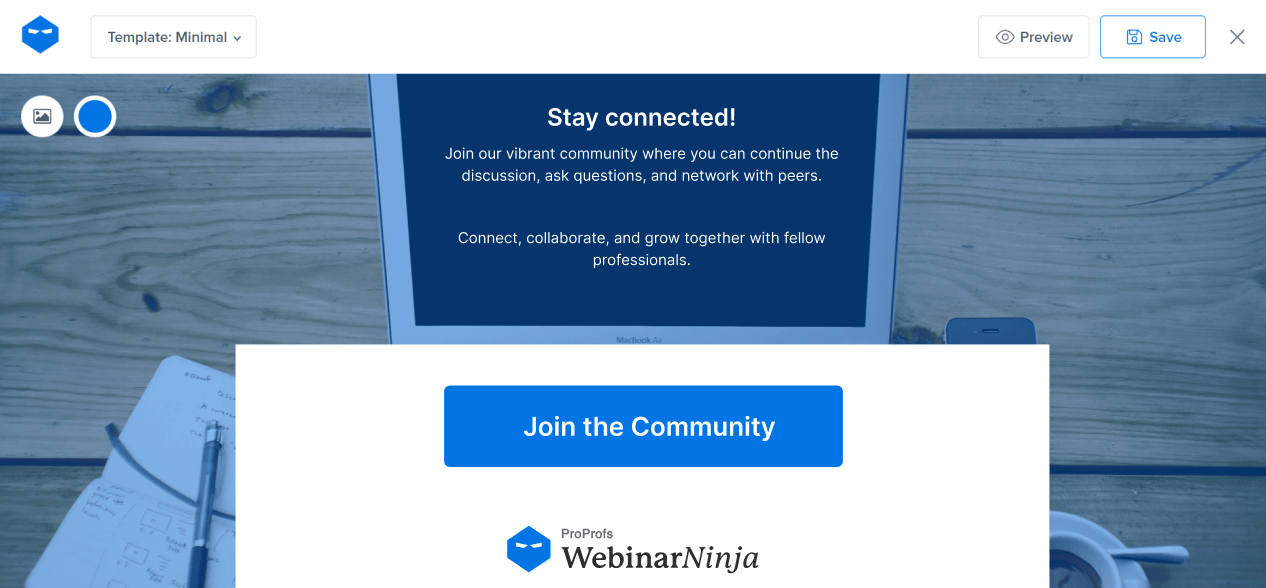
Strategy:
- Target Audience: Industry peers, customers, partners, and thought leaders.
- Content: Host panel discussions, roundtables, or workshops that facilitate two-way engagement and sharing of ideas. Focus less on your product and more on building a community.
- Promotion: Reach out via industry groups, LinkedIn, or co-host with relevant organizations or influencers to attract diverse attendees.
- Call-to-Action: Encourage attendees to join an ongoing community, forum, or regular event series for continued engagement.
- Follow-up: Keep the conversation going through post-webinar discussions, group chats, or dedicated online spaces.
Maximize Impact Through Effective Webinar Goals
While we conclude, it’s quite obvious that setting clear, actionable goals is essential for running successful webinars that engage your audience and deliver meaningful outcomes.
Whether you’re focused on lead generation, brand awareness, or education, having specific objectives will help you drive impactful results.
Also, a powerful webinar tool like WebinarNinja can streamline this process with its built-in features, such as advanced analytics, automated follow-ups, audience engagement tools, and seamless integrations.
These delightful features help you set, measure, analyze, and achieve your webinar goals more efficiently, ensuring your webinars deliver maximum value and success.
Want to host a webinar for free?
Use WebinarNinja to teach, improve marketing, and grow your sales.



